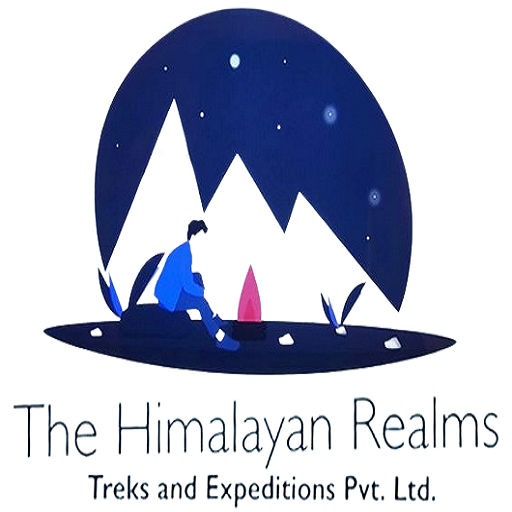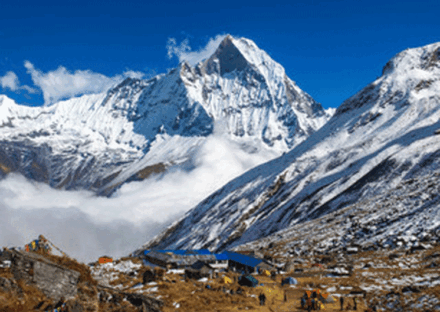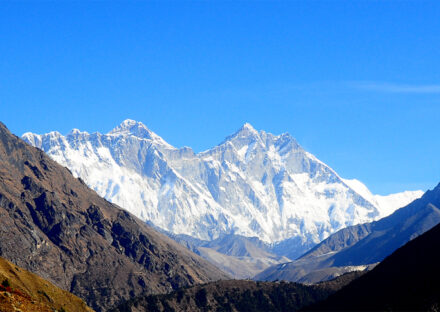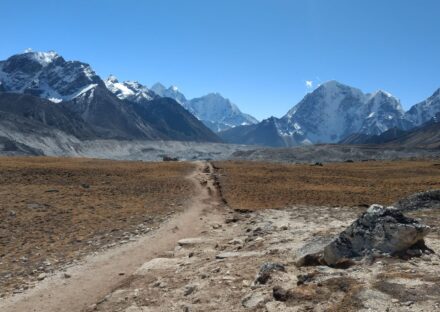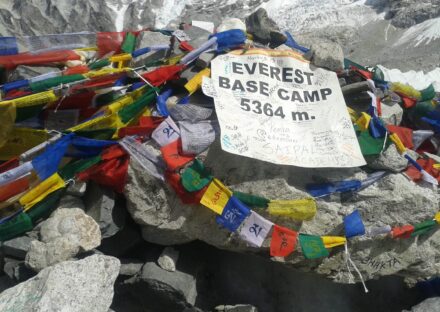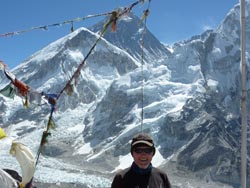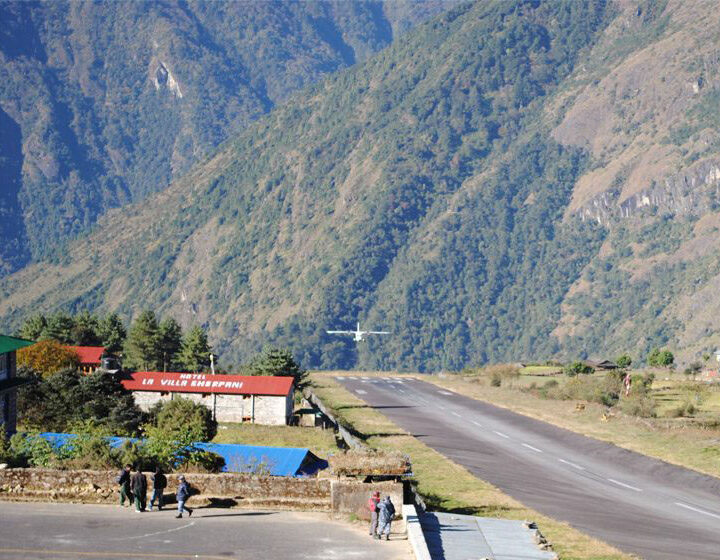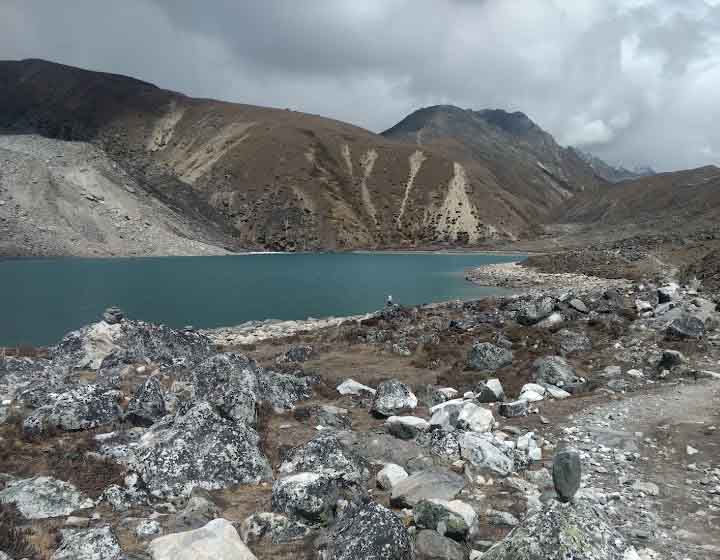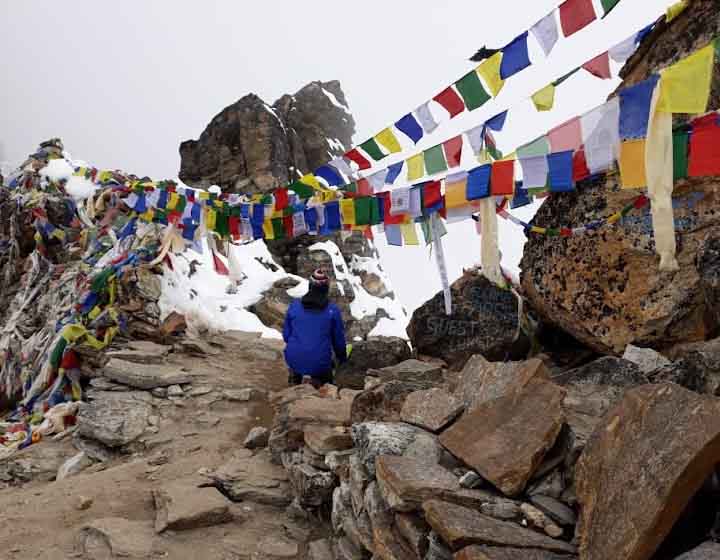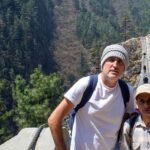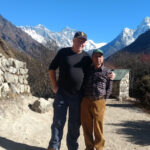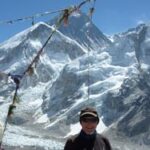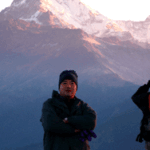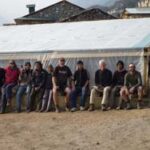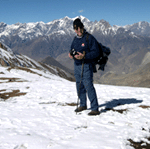As the trek progresses deeper into the Khumbu Valley, it gradually ascends through breathtaking landscapes, passing by iconic landmarks such as Dingboche and Lobuche. In the process, trekkers not only experience the ever-changing terrain but also marvel at the awe-inspiring beauty of Ama Dablam, Lhotse, and, of course, Everest itself. Moreover, with each step forward, the sense of adventure intensifies, as every turn unveils new and dramatic perspectives of the towering Himalayan giants. At the same time, the increasing altitude adds to the challenge, making acclimatization stops crucial for a safe and enjoyable journey. In addition, the route presents unique opportunities to engage with local Sherpa communities, offering deeper insight into their rich traditions and way of life. Ultimately, this remarkable journey immerses trekkers in both the natural splendor and cultural heritage of the region, leaving them with unforgettable memories of the majestic Himalayas.

- Details
- Short Itinerary
Itinerary
Itinerary- Useful Info
- Photos
Trip overview
The Everest Base Camp Heli trek offers a unique opportunity to explore the iconic Himalayan landscape, beginning with a thrilling flight from Kathmandu to Lukla, the gateway to the Himalayas. From Lukla, the trek follows a well-established path that meanders through picturesque Sherpa villages, where trekkers are welcomed by the local communities. The route leads through lush valleys and dense rhododendron forests, with towering snow-capped peaks serving as a stunning backdrop. Along the way, trekkers cross suspension bridges adorned with colorful prayer flags, adding a sense of spirituality to the journey. With each step, the trek reveals more of the region’s rich culture and timeless way of life, while the majestic views of the surrounding mountains continue to captivate. This journey provides an unforgettable experience of nature, culture, and adventure as trekkers approach the world’s highest peak—Everest itself.
Acclimatization and Exploration
As trekkers ascend, it’s crucial to acclimatize to the increasing altitude. Rest days in villages like Namche Bazaar allow for exploration of local culture, visits to monasteries, and breathtaking views of the surrounding peaks.
Trekking Through the Khumbu Valley
The final leg of the journey leads to Everest Base Camp, a bustling hub of colorful tents and mountaineering activity during climbing season. Here, trekkers stand in awe of the world’s highest mountain, surrounded by towering glaciers and jagged peaks. Reaching Everest Base Camp is a remarkable feat, a testament to physical and mental endurance. It’s an experience that leaves a lasting impression, a connection to the raw power and beauty of nature.
Descending and Reflecting
The return journey offers a different perspective, a chance to reflect on the incredible experience and the challenges overcome. The memories forged on the trek to Everest Base Camp will undoubtedly last a lifetime.
EBC trek to returm Pheriche to Lukla by Helicopter.
It is a short term trekking package in the Everest region. The EBC Heli Trek is quite similar to the 10-day Everest View Trek, offering an incredible trekking experience.
Experience the ultimate Everest adventure with a perfect blend of trekking and luxury. This journey takes you deep into the heart of the Himalayas, leading you to Everest Base Camp (5,346m) and the iconic Kalapathar (5,550m), where you’ll witness breathtaking panoramic views of Mount Everest, Pumori, and surrounding peaks.
After achieving this incredible milestone, elevate your experience with a scenic helicopter flight from Lobuche to Lukla, offering a thrilling aerial perspective of the Everest region. This not only saves time but also provides an unforgettable way to conclude your trek before returning to Kathmandu.
Perfect for those seeking both adventure and comfort, this trek is designed for explorers who want to witness Everest up close while enjoying a seamless and spectacular journey back.
The Everest Base Camp (EBC) trek passes through several traditional Sherpa settlements, each rich in culture and heritage. The Sherpa people, who inhabit the Khumbu region, are known for their hospitality, resilience, and deep-rooted Buddhist traditions.
Key Settlements & Cultural Insights (with Transitional Words) Lukla (Gateway to Everest)
To begin with, the journey starts in Lukla, a bustling town where trekkers first experience Sherpa culture. The town has numerous teahouses, lodges, and a vibrant marketplace. Moreover, prayer flags, mani walls, and chortens reflect Buddhist influences.
Phakding (Riverside Village)
Moving ahead, trekkers descend to Phakding, a peaceful village along the Dudh Koshi River. In addition to farming and tourism, locals engage in yak herding. Furthermore, centuries-old monasteries, such as Rimijung Monastery, showcase their religious devotion.
Namche Bazaar (Cultural & Commercial Hub)
As one ascends, Namche Bazaar emerges as the main trading hub of the Khumbu region. Not only does it serve as a marketplace for local and Tibetan traders, but it also seamlessly blends tradition with modernity. For instance, while visitors can immerse themselves in the rich heritage by exploring the Sherpa Culture Museum and ancient monasteries, they can also indulge in contemporary comforts by relaxing in modern cafés and savoring fresh treats from local bakeries.
Tengboche (Spiritual Center)
Continuing the trek, Tengboche is home to the renowned Tengboche Monastery, the largest Buddhist monastery in the region. In particular, monks perform daily rituals, and during the Mani Rimdu Festival, a vibrant mask dance ceremony takes place.
Dingboche (Agricultural Settlement at High Altitude)
As the trail progresses, Dingboche offers a glimpse into high-altitude Sherpa farming practices. Unlike lower villages, people here rely on barley, potatoes, and yak husbandry. Additionally, stone walls protect crops from harsh winds.
Lobuche & Gorak Shep (Final Settlements before Base Camp)
Eventually, trekkers reach Lobuche and later Gorak Shep, the last teahouse stop before Everest Base Camp. Since these settlements are at high altitudes, permanent habitation is limited. Instead, they serve as seasonal accommodations for trekkers and climbers.
Everest Base Camp (Cultural Convergence Point)
Ultimately, Everest Base Camp itself is not a permanent settlement but a seasonal home for mountaineers. Here, people from diverse cultures, including Sherpas, climbers, and support staff, interact, creating a unique cultural exchange.
Sherpa Culture & Lifestyle
Religion: Primarily Tibetan Buddhism, evident in monasteries, prayer flags, and mani stones.
Festivals: Mani Rimdu (Tengboche), Lhosar (Sherpa New Year), and Dumje are widely celebrated. Traditional Attire: Men wear Chhuba (long robes), while women wear Bakhu with colorful aprons. Livelihood: Historically traders and farmers, many Sherpas have become legendary mountaineers and trekking guides.
Short Itinerary
Day 1: Arrival in Kathmandu and transfer to your hotel.
Day 2: Fly to Lukla and trek to Phakding.
Day 3: Trek to Namche Bazaar.
Day 4: Acclimatization day in Namche Bazaar.
Day 5: Trek to Tengboche.
Day 6: Trek to Dingboche.
Day 7: Acclimatization day in Dingboche.
Day 8: Trek to Lobuche.
Day 9: Trek to Everest Base Camp and return to Gorak Shep.
Day 10: Hike to Kala Patthar then trek to Phericge and return Lukla by Helicopter
Day 11: fly back to Kathmandu
Day 12: Departure from Kathmandu.
Itinerary
After arrival at Tribhuwan International Airport Kathmandu, our office representative greets you and takes you to your hotel. Then you will check into the hotel, cool off and take a rest. Night stay at hotel in Kathmandu.
You will fly early in the morning to Lukla, where all Everest treks start. You'll follow a path that slowly leads to Chelung village, from where you can see Mount Khumbila, a sacred mountain that has never been climbed. From there you slowly descend to Phakding walking Distance of 3-4 hours. Overnight at the lodge in Phakding. Meals included: breakfast, lunch and dinner
Walking distance 5 - 6 hours which the path leads north through the Benkar valley. You'll cross the Dudh Koshi River and pass the towns of Chumoa and Monjo before reaching the entrance to Everest National Park. After entering the park, you will make your way up a steep trail with incredible views. Ascending further, you arrive at Namche Bazaar, the largest city in the Everest region. You will spend the night in the Namche Bazaar.
Meals included: Breakfast, lunch, and dinner
You are now in one of the most important parts of the Everest region and Sagarmatha National Park and can enjoy the sunrise over the Himalayas, including Everest, Nuptse, Ama Dablam, Thamserku, Lhotse, Kongde and many more. If you are interested in a day hike, you can walk to Khumjung village. You will spend the night in the Namche Bazaar.Meals included: Breakfast, lunch, and dinner
You'll walk 5 - 6 hours through the Dudh Koshi River and the equally renowned ascent with rhododendron forests to Tengboche. Going down to the Dudh Kish River, you will enjoy the views of the mountain peaks. In Tengboche, you will visit Tengboche Monastery, the largest monastery in the region. Overnight in Tengboche.
Meals included: Breakfast, lunch, and dinner
You'll walk through the forests full of lush trees: birches, conifers, and rhododendrons. This trip rewards you with an impressive view of the mountain Everest, Lhotse, and Ama Dablam. The picturesque path leads to Devuche, crosses the Imja River, and leads to Pangboche. The higher trails of Pangboche reward you with a perfect view of the Himalayas and the Pangboche Monastery.The trek continues to the Imja Valley, the Lobuche River, and finally begins with the ascent to Dingboche. Night stay at Dingboche.
Meals included: Breakfast, lunch, and dinner
Dingboche is a popular stop for hikers and climbers on the way to Mount Everest, Ama Dablam, or Imja Tse. You'll be in Dingboche for acclimatizing.
Meals included: Breakfast, lunch, and dinner
Walking distance 5-6 hours where you'll walk up a steep path to Chupki Lhara, you will get a series of stones with prayer flags serving as monuments to the tenth climber of Everest Babu Chiri Sherpa, who died on a mission to climb Everest. Then we go to the moraine of the Khumbu glacier and look at several vital peaks such as Khumbutse, Lingtren, Pumori, and Mahalangur Himal. Overnight in Lobuche.
Meals included: Breakfast, lunch, and dinner
You'll be heading to Everest base camp through the vast Gorak Shep Lake. In a straight line, you'll also find the monuments of the Indian mountaineers. The trek is strenuous due to high altitude you may get rocky dunes, streams, and moraines before getting Everest Base Camp. Arriving at Everest base camp, you'll see mountaineering tents that stand out in bright colors from the monotony of the grey surroundings. You can see Mount Nuptse, Pumori, and Khumbuste from the Everest base camp. You'll return to Gorak Shep for a overnight stay at Gorak Shep. Meals included: Breakfast, lunch, and dinner
You'll wakeup an early morning and head to Kalapatthar Peaks known as Lingtren, Khumbutse, and Changtse tower can be seen in the east as Everest is revealed. However, when you reach Kalapatthar (5,545 m), you can take a 360-degree view of the Mount Everest up close. You'll shoot video and photos, enjoy the beautiful panorama of the mountains, and then return to Gorak Shep. We descend Gorak Shep to Labuche and take a helicopter flight to Lukla. After admiring the incredible beauty of the Himalayas, Night stay at hotel in Lukla. Meals included: Breakfast, lunch, and dinner
Day 11: Lukla to Kathmandu by flight
Your Everest Base Camp trip ends in Lukla. We'll ascend to Kathmandu by flight.
Meals included: Breakfast
Once you'll reach in Kathmandu from Lukla flight after having breakfast you'll have free time for rest, nearby sightseeing and shopping etc. Then we'll take you for your next destination in the Tribhuvan International Airport for final departure this is last departure from Kathmandu to your own home town destionation.
Useful Info
Best Times to Visit: The ideal seasons for the Everest Base Camp Heli Trek are spring (March to May) and autumn (October to November) when the weather is stable and visibility is clear.
Physical Fitness: A moderate level of fitness is required for this trek. Prepare with regular exercise and acclimatization hikes,
Altitude Sickness: Be aware of the symptoms of altitude sickness and take necessary precautions. Drink plenty of water, ascend gradually, and consult your guide if you experience any discomfort.
Permits and Regulations: Obtain the necessary permits, including the Sagarmatha National Park entry permit and the TIMS card (Trekkers' Information Management System).
Download pdf brochure
